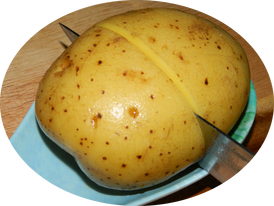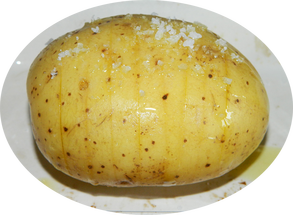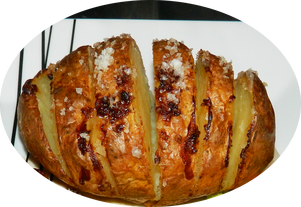Cooking Guidelines
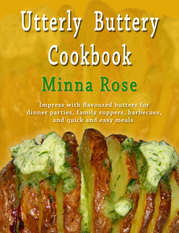
Tips for cooking meat, fish, and sides.
These are particularly tasty with the flavoured butters detailed in the Utterly Buttery Cookbook.
Flavoured butters are very versatile and can be incorporated into your favourite cooking method, either by covering the meat when cooking in the oven, or adding a pat of butter to the dish once cooked.
Red Meat
 Roast Beef with Horseradish and Mustard Butter, Ready to Roast
Roast Beef with Horseradish and Mustard Butter, Ready to Roast
Roasting Beef/Lamb/Pork Joints:
1. Preheat your oven to 240˚C/450˚F/Gas Mark 8
2. Halve carrots lengthways, quarter potatoes, peel and quarter red onions and add to the bottom of a roasting pan with cloves of garlic.
3. Smear your meat with your chosen butter, rub it in and place on top of the vegetables.
4. For beef and lamb, turn the oven down to 200˚C/400˚F/GM 6, put the roasting pan in the centre and roast.
5. Half an hour before the cooking time ends (see timings in next point), baste your meat and place another pat of butter on top of the joint, then sprinkle a tablespoon of water over the veg, if required, to prevent burning.
Also put your empty, oiled Yorkshire pudding in to heat up if appropriate.
Cooking times for roasting beef and lamb:
Rare: 20 minutes/500g (1lb) plus 20 minutes.
Medium: 25 mins/500g (1lb)plus 25 minutes.
Well done: 30 minutes per 500g (1lb) plus 30 minutes.
Cooking times for roasting pork:
Follow points 1-3 above, then preheat oven to 240˚C/450˚F/GM 8, rubbing butter into the flesh only, then roast pork for 20 minutes. Then reduce the temperature to 180˚C/350˚F/GM 5 and continue to cook for 20 minutes per 500g/pound.
When the cooking time is over, take the roasting pan out of oven, add pats of butter to the meat, then cover with tin foil and a clean tea towel to rest for 15-30 minutes while you make your Yorkshire puddings, if appropriate, and gravy.
1. Preheat your oven to 240˚C/450˚F/Gas Mark 8
2. Halve carrots lengthways, quarter potatoes, peel and quarter red onions and add to the bottom of a roasting pan with cloves of garlic.
3. Smear your meat with your chosen butter, rub it in and place on top of the vegetables.
4. For beef and lamb, turn the oven down to 200˚C/400˚F/GM 6, put the roasting pan in the centre and roast.
5. Half an hour before the cooking time ends (see timings in next point), baste your meat and place another pat of butter on top of the joint, then sprinkle a tablespoon of water over the veg, if required, to prevent burning.
Also put your empty, oiled Yorkshire pudding in to heat up if appropriate.
Cooking times for roasting beef and lamb:
Rare: 20 minutes/500g (1lb) plus 20 minutes.
Medium: 25 mins/500g (1lb)plus 25 minutes.
Well done: 30 minutes per 500g (1lb) plus 30 minutes.
Cooking times for roasting pork:
Follow points 1-3 above, then preheat oven to 240˚C/450˚F/GM 8, rubbing butter into the flesh only, then roast pork for 20 minutes. Then reduce the temperature to 180˚C/350˚F/GM 5 and continue to cook for 20 minutes per 500g/pound.
When the cooking time is over, take the roasting pan out of oven, add pats of butter to the meat, then cover with tin foil and a clean tea towel to rest for 15-30 minutes while you make your Yorkshire puddings, if appropriate, and gravy.
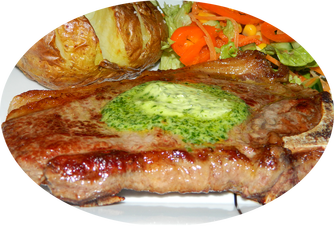 Sirloin Steak with Garlic Butter
Sirloin Steak with Garlic Butter
Beef Steak:
1. Heat 1 tablespoon of olive oil in a frying pan, then fry your steaks 2-5 minutes each side depending on the thickness of your meat and whether you prefer your steak rare, medium or well done.
2. Check the steak is cooked to your preference by touch:
Rare: soft (approx. 4-6 minutes).
Medium: bouncy (approx. 8-10 minutes)
Well done: firm (approx. 10-12 minutes).
3. Unwrap your butter, and cut into slices. Place the steaks on to a plate and place a slice of butter on top of each steak. Cover loosely with foil for five minutes to rest before serving.
1. Heat 1 tablespoon of olive oil in a frying pan, then fry your steaks 2-5 minutes each side depending on the thickness of your meat and whether you prefer your steak rare, medium or well done.
2. Check the steak is cooked to your preference by touch:
Rare: soft (approx. 4-6 minutes).
Medium: bouncy (approx. 8-10 minutes)
Well done: firm (approx. 10-12 minutes).
3. Unwrap your butter, and cut into slices. Place the steaks on to a plate and place a slice of butter on top of each steak. Cover loosely with foil for five minutes to rest before serving.
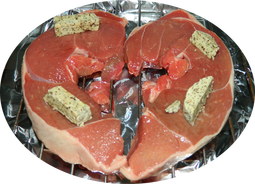 Lamb Steaks Ready to Grill with Mint Butter
Lamb Steaks Ready to Grill with Mint Butter
Lamb Steaks:
Grill for 10-14 minutes, depending on the thickness of the steaks and whether you like your lamb pink or well done, and turn occasionally as you cook.
When ready, plate up, add a pat of your preferred butter and cover loosely with foil to allow the meat to rest for 2-3 minutes before serving.
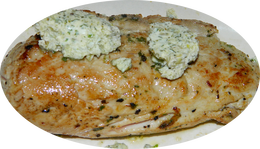 Pork Fillet Seared and Ready to Roast with Sage and Shallot Butter
Pork Fillet Seared and Ready to Roast with Sage and Shallot Butter
Pork Fillet:
1. Sear the fillet in a hot frying pan on the hob, then roast whole for 20-25 minutes at 200˚C/400˚F/GM 6.
Remove from the oven and smother with flavoured butter.
2. Alternatively, slice into medallions and pan fry in flavoured butter.
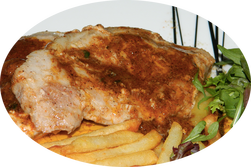 Texan Pork Chops
Texan Pork Chops
Pork Steaks/Chops:
Grill or griddle for 8-10 minutes, depending on the thickness of the meat, turning occasionally until cooked through, and taking care not to overcook.
Remove from the pan and add a pat of your chosen butter to serve.
Turkey and Chicken
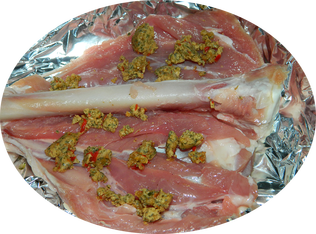 Turkey Drumstick Ready to Roast with Cajun Butter
Turkey Drumstick Ready to Roast with Cajun Butter
Turkey Leg:
1. Press your fingers into the meat to feel for the groove between the muscles. Take a small sharp knife and cut down this groove lengthways.
2. Find the main bone with your knife and cut the meat away along the length of it to open up the drumstick into a butterfly shape.
3. Rub your chosen flavoured butter into the flesh, then skin side of the meat.
4. Roast at 200˚C/400˚F for approximately one and a half hours until the meat is cooked, turning and basting after half an hour, then every fifteen minutes.
1. Press your fingers into the meat to feel for the groove between the muscles. Take a small sharp knife and cut down this groove lengthways.
2. Find the main bone with your knife and cut the meat away along the length of it to open up the drumstick into a butterfly shape.
3. Rub your chosen flavoured butter into the flesh, then skin side of the meat.
4. Roast at 200˚C/400˚F for approximately one and a half hours until the meat is cooked, turning and basting after half an hour, then every fifteen minutes.
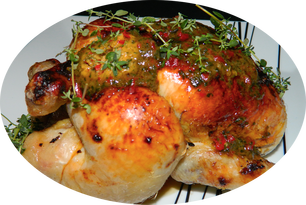 Roast Chicken with Jerk Butter
Roast Chicken with Jerk Butter
Whole Roast Chicken:
Dot the (thoroughly defrosted) chicken with pats of your butter, cover with foil and roast at 220˚C/375˚F/Gas Mark 5 for 1 hour/kilo (30 minutes/pound) plus ½ hour.
Baste regularly, and uncover for the final 30 minutes. Ensure the chicken juices run clear before serving with another pat of your chosen butter.
Dot the (thoroughly defrosted) chicken with pats of your butter, cover with foil and roast at 220˚C/375˚F/Gas Mark 5 for 1 hour/kilo (30 minutes/pound) plus ½ hour.
Baste regularly, and uncover for the final 30 minutes. Ensure the chicken juices run clear before serving with another pat of your chosen butter.
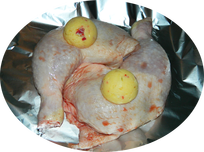 Chicken Legs Ready to Cook with Sweet Chilli Butter
Chicken Legs Ready to Cook with Sweet Chilli Butter
Chicken Pieces:
1. Can be cooked in the same way as the roast chicken above (usually 35-45 minutes)
2. Alternatively, cook uncovered without the butter, then serve with a pat of
room-temperature butter on top of the breast/leg.
1. Can be cooked in the same way as the roast chicken above (usually 35-45 minutes)
2. Alternatively, cook uncovered without the butter, then serve with a pat of
room-temperature butter on top of the breast/leg.
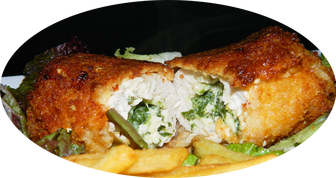 Chicken Kiev Using Garlic Butter
Chicken Kiev Using Garlic Butter
Chicken Kievs:
Place large chicken breast fillets into a freezer bag, one at a time, and use a rolling pin to bash them flat.
Place a teaspoonful of your chosen flavoured butter in the centre of each, and roll the chicken around it as securely as possible and tuck the ends in.
Dip the stuffed chicken breast into flour to cover (you can also season the flour with paprika to add more flavour), then beaten raw egg, then breadcrumbs, then repeat all three stages.
Bake in the oven 20-25 minutes at 200˚C/400˚F/Gas Mark 6 until the chicken is thoroughly cooked.
Place large chicken breast fillets into a freezer bag, one at a time, and use a rolling pin to bash them flat.
Place a teaspoonful of your chosen flavoured butter in the centre of each, and roll the chicken around it as securely as possible and tuck the ends in.
Dip the stuffed chicken breast into flour to cover (you can also season the flour with paprika to add more flavour), then beaten raw egg, then breadcrumbs, then repeat all three stages.
Bake in the oven 20-25 minutes at 200˚C/400˚F/Gas Mark 6 until the chicken is thoroughly cooked.
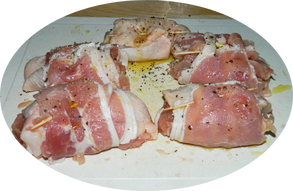 Chicken Thigh Parcels with Lemon and Coriander Butter, Ready to Cook
Chicken Thigh Parcels with Lemon and Coriander Butter, Ready to Cook
Chicken Thigh Parcels:
Bone the thighs by running the tip of a small, sharp knife down the length of the bone, cutting away the meat, then cut the bone away at the ends, paying attention to the ligaments.
Open out the thigh, wash your hands, then place a teaspoonful of butter in the centre of each thigh. Roll the thigh around butter then place on a rasher of bacon and roll again.
Secure with a wooden cocktail stick and bake in the oven 200˚C/400˚F/Gas Mark 6 for 30-40 minutes until the chicken juices run clear.
Bone the thighs by running the tip of a small, sharp knife down the length of the bone, cutting away the meat, then cut the bone away at the ends, paying attention to the ligaments.
Open out the thigh, wash your hands, then place a teaspoonful of butter in the centre of each thigh. Roll the thigh around butter then place on a rasher of bacon and roll again.
Secure with a wooden cocktail stick and bake in the oven 200˚C/400˚F/Gas Mark 6 for 30-40 minutes until the chicken juices run clear.
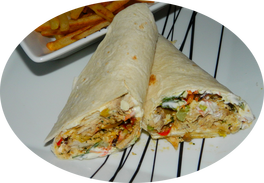 Chicken Strips Stir-Fried in Piri-Piri Butter in Wraps
Chicken Strips Stir-Fried in Piri-Piri Butter in Wraps
Stir Fry – with Rice, Salad or Wraps:
Fry sliced onions and red peppers if required in a tablespoon of olive oil for a couple of minutes, stirring regularly, until soft. Add strips of chicken, and continue to fry until the chicken is browned and cooked through properly.
Turn off the heat, add a pat of your flavoured butter, cover and allow the residual heat to melt the butter.
Mix well and serve in wraps with salad leaves and crème fraiche.
Fry sliced onions and red peppers if required in a tablespoon of olive oil for a couple of minutes, stirring regularly, until soft. Add strips of chicken, and continue to fry until the chicken is browned and cooked through properly.
Turn off the heat, add a pat of your flavoured butter, cover and allow the residual heat to melt the butter.
Mix well and serve in wraps with salad leaves and crème fraiche.
Fish
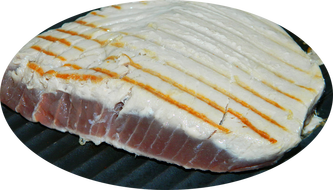 Tuna Steak Griddling - Delicious with Thai Butter
Tuna Steak Griddling - Delicious with Thai Butter
Tuna Steaks:
Place your griddle pan on the hob and heat. Rub a small amount of olive oil on to each side of your tuna steak, then place in the pan and griddle 2-3 minutes each side, depending on the thickness of the steak.
Remove from the heat while still dark red in the middle – this will avoid overcooking and the residual heat will continue to cook the fish through.
Serve the tuna steak with a pat of your desired butter.
Place your griddle pan on the hob and heat. Rub a small amount of olive oil on to each side of your tuna steak, then place in the pan and griddle 2-3 minutes each side, depending on the thickness of the steak.
Remove from the heat while still dark red in the middle – this will avoid overcooking and the residual heat will continue to cook the fish through.
Serve the tuna steak with a pat of your desired butter.
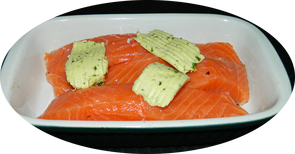 Salmon Fillets Ready to Bake with Lemon and Coriander Butter
Salmon Fillets Ready to Bake with Lemon and Coriander Butter
Oven-Baked Salmon or White Fish Fillets/Steaks:
Rub the base of an ovenproof dish with flavoured butter, then place your fish fillets or steaks in the dish and place a knob of butter on top of each portion.
Cover the dish with foil and bake in a pre-heated oven 200˚C/350˚F/Gas Mark 4 for 20-30 minutes for steaks and thick fillets, 10-20 minutes for thin fillets.
Keep an eye on them as they are cooking – they are ready when a white moisture exudes from them.
Rub the base of an ovenproof dish with flavoured butter, then place your fish fillets or steaks in the dish and place a knob of butter on top of each portion.
Cover the dish with foil and bake in a pre-heated oven 200˚C/350˚F/Gas Mark 4 for 20-30 minutes for steaks and thick fillets, 10-20 minutes for thin fillets.
Keep an eye on them as they are cooking – they are ready when a white moisture exudes from them.
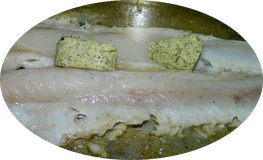 Cod Fillet Pan-Frying with Dill and Lemon Butter
Cod Fillet Pan-Frying with Dill and Lemon Butter
Pan-Fried Salmon or White Fish Fillets/Steaks:
Heat a frying pan and add a pat of butter, then add your fish fillets/steaks.
When cooked halfway up their thickness, add more butter to the surface of the fish, cover and turn off heat to allow the residual heat to finish the cooking.
Serve topped with another pat of flavoured butter.
Heat a frying pan and add a pat of butter, then add your fish fillets/steaks.
When cooked halfway up their thickness, add more butter to the surface of the fish, cover and turn off heat to allow the residual heat to finish the cooking.
Serve topped with another pat of flavoured butter.
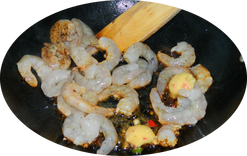 Prawns Stir-Frying with Sweet Chilli Butter
Prawns Stir-Frying with Sweet Chilli Butter
Stir-Fried Prawns:
Heat a wok and add a couple of pats of your chosen flavoured butter.
Add fresh prawns, and stir fry until the prawns are cooked through (turning from grey to pink), and are coated with butter.
Serve drizzled with the melted butter from the pan.
Heat a wok and add a couple of pats of your chosen flavoured butter.
Add fresh prawns, and stir fry until the prawns are cooked through (turning from grey to pink), and are coated with butter.
Serve drizzled with the melted butter from the pan.
Sides
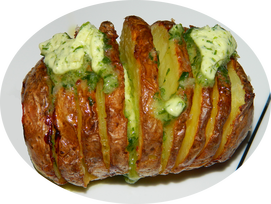 Oven-Baked Jacket Potato with Garlic Butter
Oven-Baked Jacket Potato with Garlic Butter
Oven-Baked Hasselback Potato:
1. Place a large raw potato on to a large wooden spoon or spoon rest. Slice the potato at ½ cm intervals to a depth of ¾ of the potato – the spoon will act as a guide and prevent you cutting all the way through.
2. Sprinkle with olive oil and salt and place in a hot oven (240˚C/450˚F/Gas Mark 6) for one hour.
3. Remove from the oven and serve with lashings of your favourite butter.
1. Place a large raw potato on to a large wooden spoon or spoon rest. Slice the potato at ½ cm intervals to a depth of ¾ of the potato – the spoon will act as a guide and prevent you cutting all the way through.
2. Sprinkle with olive oil and salt and place in a hot oven (240˚C/450˚F/Gas Mark 6) for one hour.
3. Remove from the oven and serve with lashings of your favourite butter.
Garlic Bread – 3 Ways
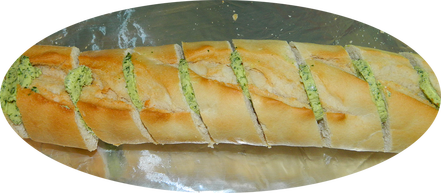 Garlic Bread Baguette, Ready to Bake
Garlic Bread Baguette, Ready to Bake
Method 1
Slice a baguette at regular 1 cm intervals, ¾ way through, insert small pats of garlic and parsley butter into each cut, then sprinkle with mozzarella cheese if desired.
Bake 200˚C/400˚F/Gas Mark 6 for approximately 10 minutes until the bread is heated through, and the butter and cheese has melted.
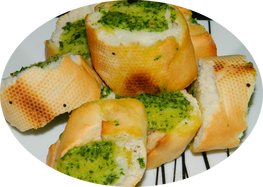 Warm Garlic Bread
Warm Garlic Bread
Method 2
Cut slices of baguette, and spread with garlic and parsley butter.
Sprinkle with grated mozzarella if desired and grill until the bread has heated through, and the butter and cheese has melted.
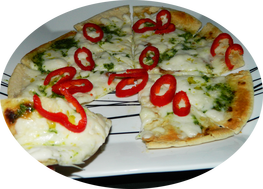 Garlic Flatbread with Mozarella and Sliced Sweet Pepper
Garlic Flatbread with Mozarella and Sliced Sweet Pepper
Method 3
Dot dabs of garlic and parsley butter over the surface of a flatbread (caramalised red onion marmalade is also nice added at this stage).
Sprinkle with grated mozzarella and sliced sweet peppers if desired and grill until bread is soft, and the butter and cheese has melted.
